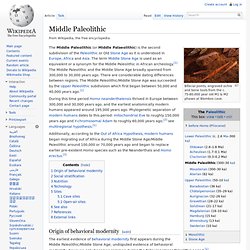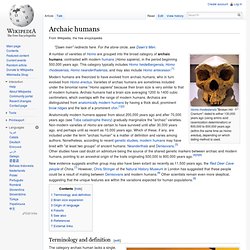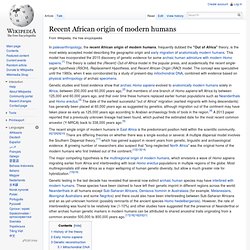

Middle Stone Age. This article is about the term as applied to African prehistory.

See Mesolithic for the "middle" period of the Stone Age in general. See Middle Paleolithic for the "middle" part of the "Old Stone Age". The Middle Stone Age (or MSA) was a period of African Prehistory between Early Stone Age and Late Stone Age. It is generally considered to have begun around 280,000 years ago and ended around 50-25,000 years ago.[1] The beginnings of particular MSA stone tools have their origins as far back as 550-500,000 years ago and as such some researchers consider this to be the beginnings of the MSA.[2] It was once considered roughly equivalent to the European Middle Paleolithic,[3] but recent discoveries of evidence for art and symbolic culture in the MSA have forced a reassessment of this idea.[4] The MSA is associated with both anatomically modern humans (Homo sapiens) as well as archaic Homo sapiens, sometimes referred to as Homo helmei.
Middle Paleolithic. Bifacial points, engraved ochre and bone tools from the c. 75-80,000 year old M1 & M2 phases at Blombos cave.

The Middle Paleolithic (or Middle Palaeolithic) is the second subdivision of the Paleolithic or Old Stone Age as it is understood in Europe, Africa and Asia. Homo rhodesiensis. Homo rhodesiensis "Broken Hill Cranium": dated to either 130,000 years ago (using amino acid racemization determination) or 800,000 to 600,000 years ago (within the same time as Homo erectus), depending on which dating method is used.

Modern humans are theorized to have evolved from archaic humans, who in turn evolved from Homo erectus. Varieties of archaic humans are sometimes included under the binomial name "Homo sapiens" because their brain size is very similar to that of modern humans. Archaic humans had a brain size averaging 1200 to 1400 cubic centimeters, which overlaps with the range of modern humans. Archaics are distinguished from anatomically modern humans by having a thick skull, prominent brow ridges and the lack of a prominent chin.[1][2] Anatomically modern humans appear from about 200,000 years ago and after 70,000 years ago (see Toba catastrophe theory) gradually marginalize the "archaic" varieties.
Terminology and definition[edit] Brain size expansion[edit] Fossils[edit] Middle Paleolithic.
Aterian age. Neanderthal. The exact date of their extinction is disputed.

Fossils found in the Vindija Cave in Croatia have been dated to between 33,000 and 32,000 years old, and Neanderthal artifacts from Gorham's Cave in Gibraltar are believed to be less than 30,000 years old, but a recent study has redated fossils at two Spanish sites as 45,000 years old, 10,000 years older than previously thought, and may cast doubt on recent datings of other sites. Cro-Magnon (Eurasian Early Modern Human) skeletal remains showing some "Neanderthal traits" have been found in Lagar Velho in Portugal and dated to 24,500 years ago, and in Cioclovina in Romania dated to 35,000 years ago, suggesting that there may have been an extensive admixture of the Cro-Magnon and Neanderthal populations throughout Europe.[10][11][12][13][14][15] With an average cranial capacity of 1600 cc,[20] Neanderthal's cranial capacity is notably larger than the 1400 cc average for modern humans, indicating that their brain size was larger.
Name[edit] Recent African origin of modern humans. In paleoanthropology, the recent African origin of modern humans, frequently dubbed the "Out of Africa" theory, is the most widely accepted model describing the geographic origin and early migration of anatomically modern humans.

This model has incorporated the 2010 discovery of genetic evidence for some archaic human admixture with modern Homo sapiens.[1] The theory is called the (Recent) Out-of-Africa model in the popular press, and academically the recent single-origin hypothesis (RSOH), Replacement Hypothesis, and Recent African Origin (RAO) model. The concept was speculative until the 1980s, when it was corroborated by a study of present-day mitochondrial DNA, combined with evidence based on physical anthropology of archaic specimens. The recent single origin of modern humans in East Africa is the predominant position held within the scientific community.[6][7][8][9][10] There are differing theories on whether there was a single exodus or several. Middle Stone Age.